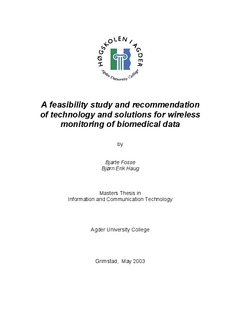| dc.description.abstract | This report contains the results of a study on wireless remote monitoring technology that has been conducted for Contel AS, though it applies to a much wider audience. The study was started because there was need for, and interest in, broad sighted information about the subject. This information has been collected and organized into this report, in addition to our own evaluations and proposals.
Remote monitoring of patients is an interesting subject. There is a lot of ongoing research and development, and many exciting new ideas and technologies are under way. This technology has the potential to change the way health care is done, letting the health sector take part in the wireless revolution. The technological evolution in this field lies far beyond the reality of today, and not a lot of wireless remote monitoring system have yet been taken into use. Improving health care requires significant changes, and changes are not done quickly when persons, and not technology, must remain in focus.
The applications and benefits of wireless remote monitoring are many and diverse. They range from greatly improved home care for chronic and post-operative patients, and improved emergency care, to letting the patient return sooner to his home and family, and free valuable hospital resources.
To get an overview of the current state of the field we have conducted a study of the available products on the market, and the plethora of ongoing reasearch effort into this field. There are many exciting products available that could benefit the health service and its patients in many ways. Yet, we have seen that the utilization of wireless remote monitoring is remarkably low. Apart from the slow process of adopting new technology, there is also the issue of lack of knowledge between both health care instances and political authorities. This may be due to the over-complex multitude of independent and proprietary solutions. A lack of established standards, and lack of utilization of those available, inhibit interoperability between products and prevents the possibility of a free market and custom solutions.
With any system handling sensitive data there are strict requirements to information security. There are laws and regulations giving a framework to protect the privacy of patients. To be familiar with these requirements is essential when developing solutions for health care. An introduction to existing laws and other requirements to remote monitoring systems is given.
An essential part of wireless remote monitorig is the wireless communication capabilities. A number of communication technologies exist with varying properties. An overview of the most used technologies is presented, and these technologies are evaluated for suitability with different types of applications. This provides a method for selecting communication technologies for different cases of remote monitoring.
In the light of the observations we have made during the study, and a dialogue with Sørlandet Sykehus Arendal, a solution for remote monitoring of oxygen saturation during sleep disorder screening is proposed. This solution will make it easier for the patient to do an overnight oxygen saturation measurement while sleeping at home. Combining results from different simultanious measurements can make better founded diagnoses. Larger scale systems that can receive data from many different sensors would be beneficial. But it still has some issues against it, like lack of standardization of communication, before it can become viable.
Introducing technology that has the potential to bring healthcare out of the hospital and into the patient’s home, replace nurses with tecnical devices, and collect sensitive information will bring many ethical considerations. These must be dealt with in order to ensure that any changes made in the health service are for the better for the patient.
Wireless remote monitoring is really an underdeveloped area today in the health care service. It will continue to become more and more important and revolutionizing for the way patients are treated in the years to come. | en |
